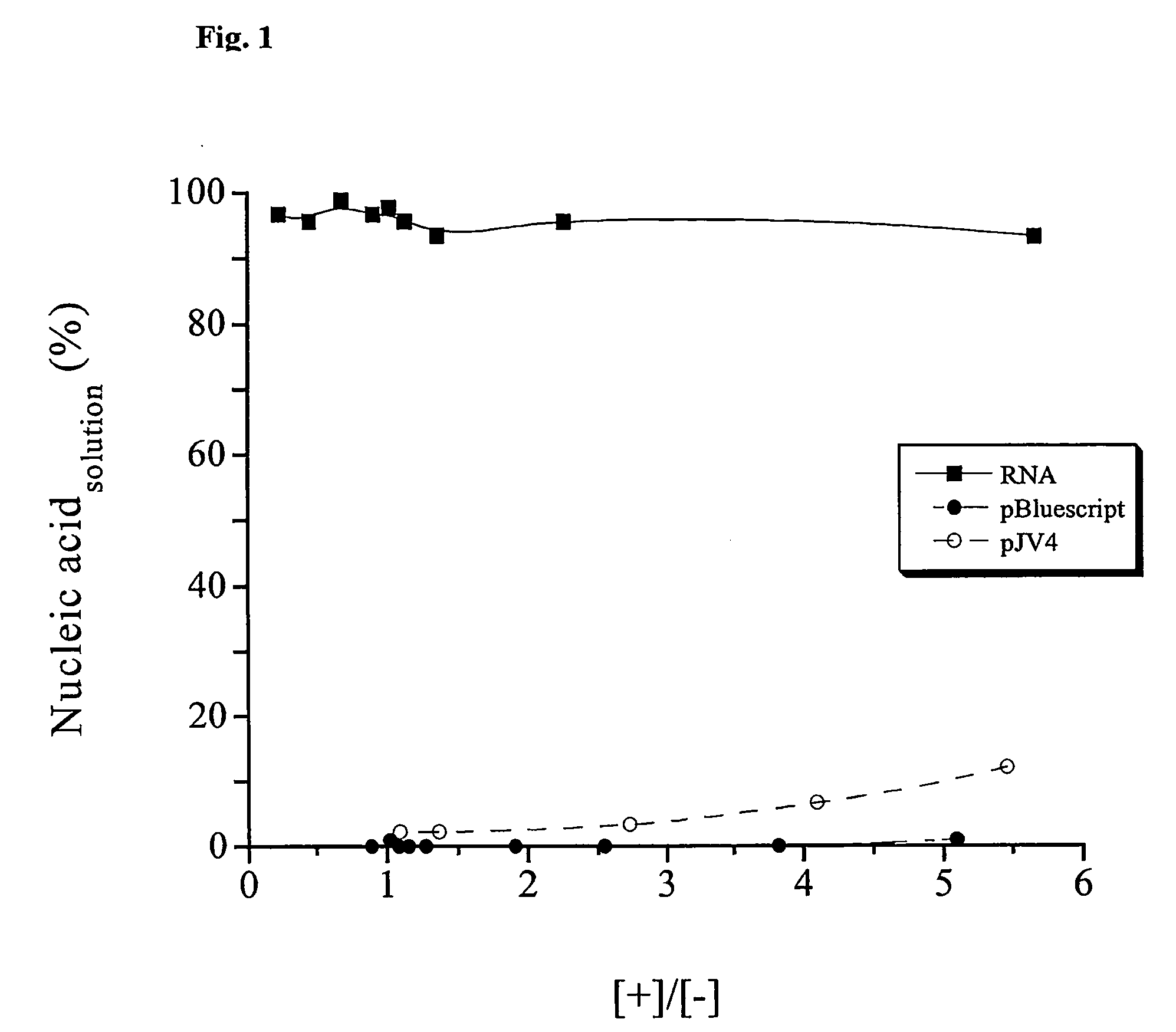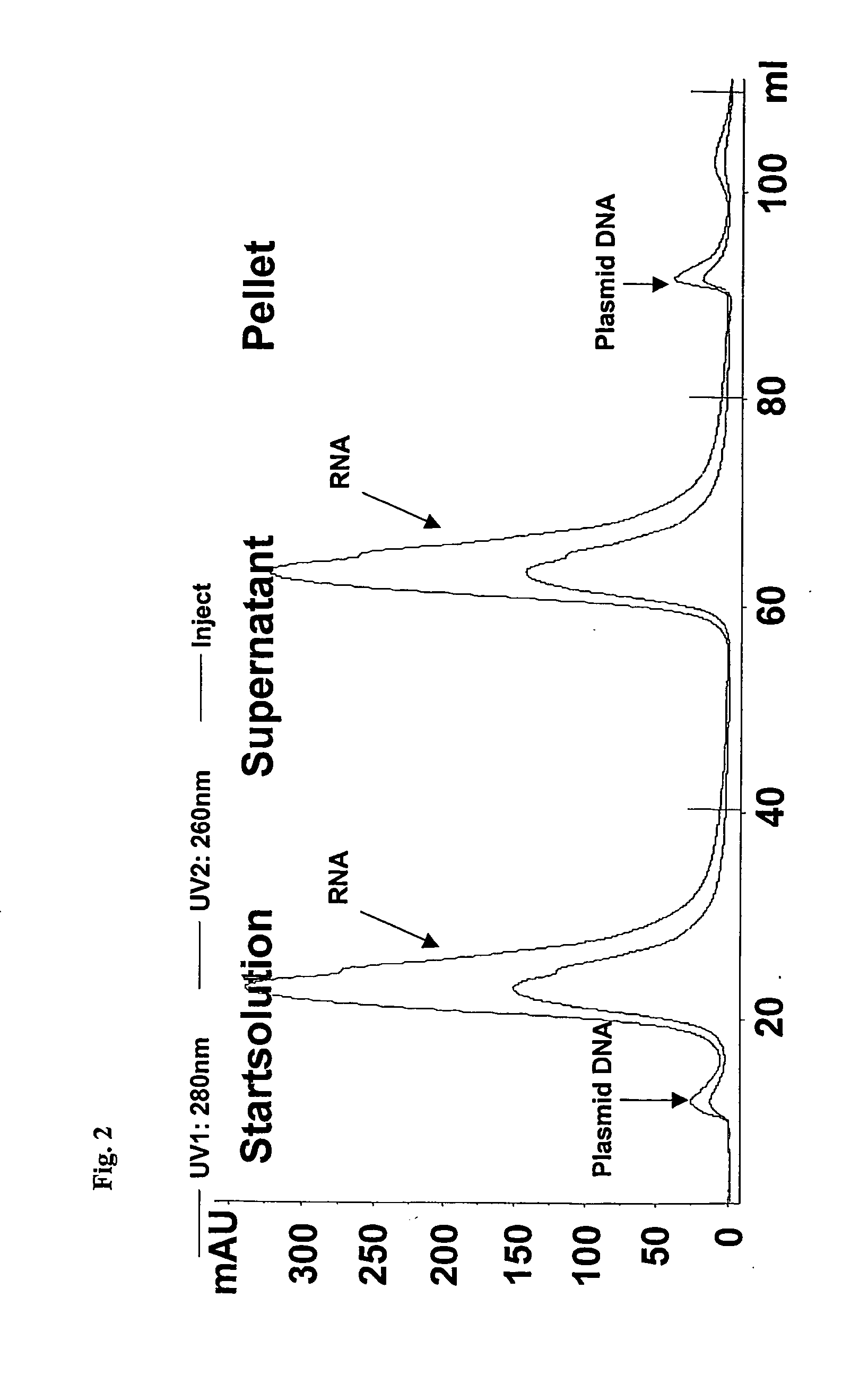Isolation of nucleic acids using a polycationic polymer as precipitation agent
a polycationic polymer and nucleic acid technology, applied in the field of isolating nucleic acids, can solve the problems of low efficiency of suggested methods, inability to precipitate plasmid dna, and inability to apply directly to cell lysates, etc., and achieve the effect of cost-effective and suitable for large-scale operations
- Summary
- Abstract
- Description
- Claims
- Application Information
AI Technical Summary
Benefits of technology
Problems solved by technology
Method used
Image
Examples
example 1
Cell Growth
[0065]E. Coli cells harbouring the plasmid was grown in a 500 ml shake flask containing 100 ml fermentation media (37° C., 160 rpm, 9 h) to an optical density of 2 (OD600 nm). 10 ml each of this overnight culture was used to inoculate four 500 ml shake flasks each containing 100 ml fermentation media and the cells were grown further for 9 h (37° C., 160 rpm) to an optical density of 6.5 (OD600 nm). All of this culture (400 ml) was used to inoculate a 15 L fermentor (Electrolux) containing 10 L of fermentation media. The cells were grown for 8.5 h (37° C., 600 rpm) to an optical density of 12.5 (OD600 nm). During fermentation the pH of the medium was kept at 7 by addition of 1 M NaOH and foam was inhibited by occasional addition of adekanol (Asahi Denka Kogyo K.K., Japan). The 10 L cell culture was pumped through sterile tubing into a 784 L fermentor (Belach bioteknik AB, Stockholm, Sweden) containing 400 L of fermentation media. The cells were grown for 10 h (37° C.) to ...
example 2
[0066] Cell lysis was performed by the alkaline lysis method as follows:
[0067] 5 g of cell paste from Example 1 was defrosted and completely resuspended by gentle vortexing in 36 ml of 10 mM Tris-HCl, pH 8, 61 mM glucose, 50 mM EDTA. The cell suspension was transferred to a plastic beaker equipped with magnetic stirring and 78 ml of 0.2 M NaOH containing 1% SDS was added and the gentle stirring was continued for 7 minutes at room temperature. After this incubation period, 59 ml of cold (5° C.) 3 M KAc, pH 5,5 was added and the solution was gently mixed by magnetic stirring for 20 minutes on an ice bath. The white precipitate formed was removed by 30 minutes centrifugation at 4° C. at 10.000 rpm in a Sorvall GSA rotor. The supernatant was finally filtered through a nylon net (Falcon Cell Strainer, 35 μm pore size).
example 2.1
Pre-Treatment of Clarified Lysate by Storage at 4° C.
[0068] The clarified lysate from Example 2 was stored at 4° C. for 6 days. The formed precipitate was removed by 30 minutes centrifuagation at 4° C. at 10 000 rpm in a Sorvall GSA rotor.
PUM
| Property | Measurement | Unit |
|---|---|---|
| optical density | aaaaa | aaaaa |
| optical density | aaaaa | aaaaa |
| pore size | aaaaa | aaaaa |
Abstract
Description
Claims
Application Information
 Login to View More
Login to View More - R&D Engineer
- R&D Manager
- IP Professional
- Industry Leading Data Capabilities
- Powerful AI technology
- Patent DNA Extraction
Browse by: Latest US Patents, China's latest patents, Technical Efficacy Thesaurus, Application Domain, Technology Topic, Popular Technical Reports.
© 2024 PatSnap. All rights reserved.Legal|Privacy policy|Modern Slavery Act Transparency Statement|Sitemap|About US| Contact US: help@patsnap.com










